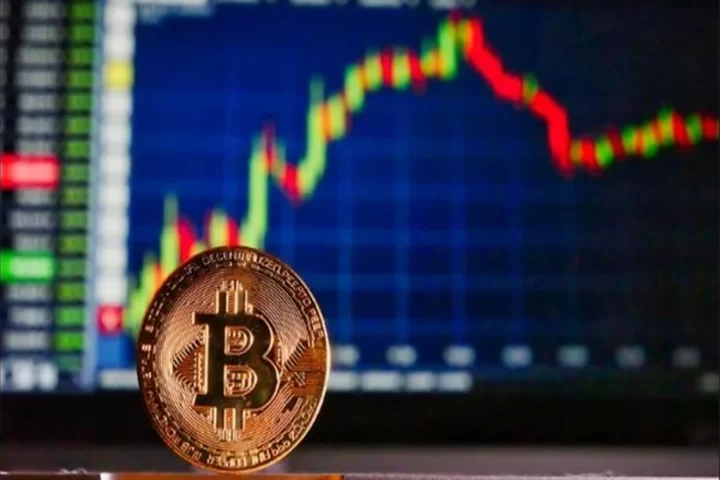The global M2 money supply’s expansion is emerging as a potential catalyst for a significant Bitcoin rally. Analysts are observing this trend closely, though they advise caution against overcommitting based on this single indicator.
Correlation Between Money Supply and Bitcoin’s Trajectory
Pav Hundal, lead analyst at Australian cryptocurrency exchange Swyftx, discussed the implications of the increasing M2 money supply on Bitcoin’s prospects. He noted, “In normal times, global loosening measures are a pretty reliable lead indicator for crypto.”
Hundal emphasized that current data indicates active spot buyers and highlighted the U.S. government’s recent decision to raise its debt ceiling by $4 trillion as a significant factor.
The year-on-year fixed exchange rate for the M2 money supply of the four major central banks reached 3.65% in January, according to MacroMicro data. Historically, an increase in the global M2 money supply has been associated with higher Bitcoin prices, driven by enhanced liquidity and reduced interest rates.
Analysts’ Perspectives on Potential Bitcoin Surge
Economist Lyn Alden has previously identified a strong correlation between global M2 money supply growth and Bitcoin’s price movements, noting that Bitcoin aligns with global M2 trends approximately 83% of the time.
Investment research entity Bravo Research highlighted that the U.S. money supply has doubled over the past decade, suggesting that this liquidity surge could fuel a parabolic rise in Bitcoin’s value.
Summary
- The global M2 money supply is expanding, a trend historically linked to Bitcoin price surges.
- Analysts warn against over-reliance on M2 growth but acknowledge its potential impact on Bitcoin.
- Swyftx lead analyst Pav Hundal notes that liquidity expansion often benefits crypto markets.
- The U.S. debt ceiling increase by $4 trillion is seen as a contributing factor to rising liquidity.
- The year-on-year M2 growth rate reached 3.65% in January, suggesting increased market liquidity.
- Economist Lyn Alden found Bitcoin follows M2 money supply trends 83% of the time.
- Research firm Bravo Research highlights that U.S. money supply has doubled in a decade, potentially fueling Bitcoin’s next rally.
- While bullish sentiment grows, some experts caution that other macroeconomic factors must be considered before predicting a parabolic rise.
The cryptocurrency market recently faced a downturn following U.S. President Donald Trump’s announcement to proceed with tariffs on Canada and Mexico. Binance CEO Richard Teng addressed this development, characterizing the market’s response as a “short-term tactical retreat” rather than a fundamental reversal.
Market Resilience in the Face of Economic Policies
Teng emphasized that the cryptocurrency market has historically demonstrated resilience in the face of macroeconomic fluctuations. He stated, “It’s important to view this as a tactical retreat, not a reversal. Crypto has been here before and bounced back even stronger.”
The recent market dip saw Bitcoin’s price fall below $90,000 on February 25, a first since November. This decline was triggered by President Trump’s confirmation that a 25% tariff on imports from Canada and Mexico would proceed as scheduled, following a prior 30-day suspension.
Investor Sentiment and Market Indicators
The Crypto Fear & Greed Index, which gauges market sentiment, dropped to 21 out of 100 on February 26, indicating “Extreme Fear.” This represents a significant decline from a “Neutral” score of 29 just two days prior. Similarly, Nansen’s Risk Barometer shifted to a “Risk-off” stance after maintaining a “Neutral” position since mid-November.
Despite these indicators, Teng remains optimistic, noting that the fundamental aspects of the cryptocurrency market continue to strengthen. He highlighted the robust demand for crypto ETFs and the ongoing applications for new launches in the U.S. as positive signs. Since the resignation of former SEC Chair Gary Gensler on January 20, asset managers have filed for ETFs linked to assets such as XRP, Cardano, Solana, and Dogecoin.
Teng concluded, “The fundamental indicators of crypto’s strength are getting stronger,” suggesting confidence in the market’s ability to recover and thrive despite current challenges.
Summary
- Binance CEO Richard Teng describes the recent crypto market decline as a “tactical retreat” rather than a full reversal.
- Bitcoin’s price fell below $90,000 on February 25 after the U.S. announced tariffs on Canada and Mexico.
- Teng emphasized that crypto has recovered from similar downturns before and expects resilience.
- The Crypto Fear & Greed Index dropped to 21 (Extreme Fear), signaling increased investor caution.
- The Nansen Risk Barometer moved to a “Risk-off” position for the first time since mid-November.
- Despite market fear, Teng highlights strong demand for crypto ETFs and increasing institutional interest.
- New ETF applications for XRP, Cardano, Solana, and Dogecoin have emerged after SEC Chair Gensler’s resignation.
- Teng remains confident in crypto’s long-term growth, despite short-term macroeconomic pressures.
In a significant market movement, U.S. spot Bitcoin exchange-traded funds (ETFs) experienced their largest-ever daily net outflows, totaling $937.9 million on February 25. This marked the sixth consecutive trading day of outflows, coinciding with Bitcoin’s price dipping below the $90,000 threshold.
ETF Exodus Amidst Bitcoin Price Decline
The substantial outflows from these ETFs occurred as Bitcoin’s value decreased by 3.4% over the previous day, reaching a 24-hour low of $86,140 from an intraday high exceeding $92,000. Leading the outflows was the Fidelity Wise Origin Bitcoin Fund (FBTC), which saw a record-setting withdrawal of $344.7 million. BlackRock’s iShares Bitcoin Trust (IBIT) followed with an outflow of $164.4 million.
Other notable outflows included $88.3 million from the Bitwise Bitcoin ETF (BITB) and a combined $151.9 million from Grayscale’s Bitcoin Trust (GBTC) and Bitcoin Mini Trust ETF (BTC).
Cumulatively, these 11 Bitcoin funds have experienced over $2.4 billion in net outflows throughout February, with only four days recording net inflows.
Industry Perspectives on the Outflows
Nate Geraci, President of the ETF Store, expressed his astonishment at the traditional financial sector’s aversion to Bitcoin and cryptocurrencies. In a February 26 post on X (formerly Twitter), he remarked, “Still amazed at how much TradFi hates Bitcoin and crypto. Huge victory laps at every downturn. Hate to break it to you, but no matter how big drawdowns are, it’s not going away.”
Analysts such as BitMEX co-founder Arthur Hayes and 10x Research’s head of research, Markus Thielen, suggest that the majority of Bitcoin ETF investors are hedge funds engaging in arbitrage strategies rather than long-term holders.
Hayes predicted on February 24 that Bitcoin’s price could decline to $70,000 due to continued ETF outflows. He explained that many IBIT holders are hedge funds that went long on ETFs while shorting CME futures to earn yields higher than short-term U.S. Treasurys. As these yields diminish alongside Bitcoin’s price, these funds may unwind their positions, impacting the market further.
Thielen’s research indicates that over half of spot Bitcoin ETF investors are involved in arbitrage, selling ETFs while buying Bitcoin futures to maintain a market-neutral stance. This strategy effectively offsets any directional market impact, suggesting that the outflows may not directly correlate with a long-term bearish outlook for Bitcoin.
Summary
- U.S. spot Bitcoin ETFs saw their largest-ever daily net outflows of $937.9 million on February 25.
- This marked six consecutive days of outflows, with Bitcoin’s price dropping below $90,000.The Fidelity Wise Origin Bitcoin Fund (FBTC) led the withdrawals with $344.7 million in outflows.
- Other major funds, including BlackRock’s IBIT and Grayscale’s GBTC, also experienced significant withdrawals.
- Over $2.4 billion in net outflows have been recorded across 11 Bitcoin ETFs in February.
- Analysts believe hedge funds engaging in arbitrage strategies are behind these outflows rather than long-term holders.
- Arthur Hayes predicts Bitcoin could drop to $70,000 due to continued ETF outflows.
- Market sentiment remains cautious, but some experts argue this trend does not indicate a long-term bearish outlook.
Bitcoin’s price has taken a sharp hit, falling to a multi-month low as broader market uncertainties weigh on investor sentiment. The decline comes amid widespread crypto liquidations and growing concerns over potential tariffs affecting the global financial landscape.
Bitcoin’s Price Decline and Liquidation Wave
Bitcoin dropped below the $90,000 mark, marking one of its steepest declines in recent months. The sell-off triggered a wave of liquidations across the crypto derivatives market, with over $500 million worth of leveraged positions wiped out in a single day.
Analysts attribute the decline to a combination of macroeconomic uncertainty, profit-taking by institutional investors, and technical factors influencing market sentiment.
One trader commented, “Bitcoin’s recent price action suggests a shift in market momentum, with increased selling pressure from large holders contributing to the downside.”
Global Tariff Concerns and Their Impact on Crypto Markets
Another key factor driving Bitcoin’s downturn is the growing uncertainty surrounding global trade policies. Reports of potential new tariffs on technology and financial products have raised fears of economic slowdowns, impacting investor confidence across multiple asset classes.
If global trade tensions escalate, risk assets like Bitcoin could face further downward pressure as investors seek safer alternatives.
Broader Crypto Market Reactions
Bitcoin’s decline also affected the wider cryptocurrency market, with major altcoins experiencing significant losses. Ethereum, Solana, and other top assets fell by 5-10% within the same timeframe, mirroring Bitcoin’s downward trend.
The sudden market correction highlights the volatility of the crypto sector, particularly during periods of macroeconomic uncertainty.
What’s Next for Bitcoin?
Despite the recent downturn, some analysts believe that Bitcoin’s long-term fundamentals remain strong. Institutional adoption, regulatory developments, and ongoing advancements in blockchain technology continue to support the case for Bitcoin as a long-term asset.
However, in the short term, traders remain cautious, closely watching key support levels and market trends to determine whether Bitcoin can stabilize or faces further downside risk.
A group of Ohio lawmakers has introduced a new bill aimed at eliminating taxes on digital asset payments, positioning the state as a potential leader in cryptocurrency adoption.
The proposed legislation, if passed, would ensure that Ohio residents and businesses can transact in digital currencies without facing additional tax burdens.
Details of the Proposed Bill
The bill, introduced by a bipartisan group of legislators, seeks to amend the state’s tax code to exempt digital asset transactions from sales and capital gains taxes. Lawmakers argue that such a measure would encourage the use of cryptocurrencies for everyday transactions, fostering innovation and investment in the state’s digital economy.
Under the proposal, Ohio would become one of the few jurisdictions in the United States to offer tax-free cryptocurrency transactions. This move could attract businesses looking to integrate blockchain-based payment systems while providing financial incentives for individuals to adopt digital currencies.
Motivation Behind the Tax Exemption
Supporters of the bill believe that digital assets should be treated similarly to cash transactions rather than taxable commodities. They argue that imposing taxes on crypto payments discourages mainstream adoption and creates unnecessary complexity for users.
One of the lawmakers backing the bill stated, “By eliminating taxes on digital asset payments, Ohio has the opportunity to establish itself as a leader in the blockchain economy and attract new businesses to the state.”
Additionally, proponents highlight the need for regulatory clarity, arguing that crypto transactions are often subject to conflicting tax treatments across different jurisdictions. A tax-free environment, they claim, would simplify compliance for businesses and individuals alike.
Challenges and Opposition
While the bill has garnered support from crypto enthusiasts and blockchain startups, it faces opposition from policymakers concerned about potential revenue losses. Critics argue that tax exemptions for digital assets could reduce state income and create loopholes for tax avoidance.
Another concern is the federal government’s stance on cryptocurrency taxation. The Internal Revenue Service (IRS) classifies digital assets as property, making them subject to capital gains taxes at the national level. If Ohio moves forward with its bill, it could face legal challenges or require additional legislative coordination at the federal level.
Potential Impact on the Crypto Industry
If passed, the legislation could set a precedent for other states to follow, potentially leading to wider adoption of cryptocurrency-friendly tax policies. Blockchain advocates see this as a crucial step in making crypto transactions more viable for everyday purchases, from coffee shops to online retail.
As lawmakers continue debating the bill, the outcome will be closely watched by the broader crypto community, particularly as states across the U.S. explore ways to regulate and integrate digital assets into their economies.
Dubai is considering new regulations that would require cryptocurrency whales to disclose their identities. This move is part of an effort to enhance financial transparency and prevent market manipulation within the digital asset sector.
Why Dubai Wants Crypto Whales to Reveal Themselves
Dubai’s financial regulators are increasingly concerned about the influence of major digital asset holders on market volatility. Crypto whales—individuals or entities holding significant amounts of cryptocurrency—can dramatically impact market prices with large buy or sell orders.
Authorities fear that these entities could engage in practices such as pump-and-dump schemes, leading to artificial price inflation followed by sharp declines that harm retail investors.
By requiring identity disclosure, regulators aim to introduce more accountability into the crypto sector, reducing the potential for market manipulation and illicit financial activities.
Proposed Regulatory Measures
The proposed regulations would likely mandate that any entity holding more than a certain threshold of digital assets—possibly $10 million or more—must disclose their holdings and identity. The information would be reported to Dubai’s financial authorities, ensuring that large-scale crypto transactions are subject to greater oversight.
Additionally, crypto exchanges operating in Dubai may be required to enforce stricter Know Your Customer (KYC) and Anti-Money Laundering (AML) policies to monitor whale transactions effectively.
Market Reactions and Concerns
While some industry leaders welcome the move as a step toward legitimacy, others argue that forced disclosure could deter institutional investors from operating in Dubai’s crypto market. Privacy advocates also raise concerns, arguing that anonymity is a core principle of cryptocurrency.
However, regulators believe that balancing transparency with investor privacy will help solidify Dubai’s reputation as a global hub for regulated crypto activities.
Future Implications for the Crypto Industry
If Dubai proceeds with these regulations, it could set a precedent for other jurisdictions to follow. Similar measures may be adopted by global financial hubs looking to enhance oversight in the crypto space.
Ultimately, Dubai’s push for transparency is another sign that governments worldwide are moving toward stricter crypto regulations, ensuring that digital assets are integrated into the mainstream financial system responsibly.
GameStop Corp. (GME) has recently received a proposal from Strive Asset Management, urging the gaming retailer to allocate its $4.6 billion cash reserves into Bitcoin (BTC). This suggestion has sparked discussions about the potential impact such a move could have on traditional finance sectors.
Proposal Details
In a letter dated February 24, 2025, Strive CEO Matt Cole recommended that GameStop not only invest its existing cash into Bitcoin but also consider issuing new equity and convertible debt to fund additional BTC acquisitions. Cole emphasized that this strategy could transform GameStop from a “meme stock to market leader,” providing a hedge against inflation and positioning the company at the forefront of financial innovation.
Market Reactions
John Haar, Managing Director at Swan Bitcoin, commented on the potential ramifications of such a strategy: “If GameStop embarks on the LBE (Leveraged Bitcoin Equity) strategy… It will bake the noodles of so many TradFi investors and commentators who think both GME and Bitcoin are a joke.” This statement underscores the disruptive potential of a major retailer integrating Bitcoin into its financial strategy, challenging traditional finance paradigms.
Strategic Implications
Cole’s proposal also suggests that GameStop should streamline operations by closing underperforming stores and enhancing its online presence. This operational shift, combined with a significant Bitcoin investment, could diversify GameStop’s revenue streams and reduce reliance on traditional gaming sales.
However, such a move is not without risks, including potential regulatory scrutiny and the inherent volatility of cryptocurrency markets.
U.S. Senator Dick Durbin has introduced the Crypto ATM Fraud Prevention Act, aiming to address the rising incidents of fraud associated with cryptocurrency ATMs. This legislative move seeks to implement protective measures for consumers, particularly senior citizens, who are often targeted by scammers exploiting these machines.
Motivation Behind the Bill
Senator Durbin highlighted a case where a constituent was defrauded of $15,000 by a scammer posing as a law enforcement official. The fraudster convinced the victim to deposit funds into a crypto ATM to avoid fictitious legal consequences. Such incidents have become increasingly common, prompting the need for regulatory intervention.
Key Provisions
The proposed legislation mandates that crypto ATM operators:
- Display clear warnings about potential scams to inform users.
- Implement measures to detect and prevent fraudulent activities at their machines.
- Impose transaction limits for new users, restricting deposits to $2,000 per day and a total of $10,000 within the initial two weeks.
- Provide full refunds to victims under specific conditions to mitigate financial losses.
These provisions aim to create “common sense guardrails” to protect consumers from falling prey to scams facilitated through crypto ATMs.
Industry Response and Future Outlook
While the bill focuses on consumer protection, it also seeks to equip law enforcement with tools to trace and combat crypto-related fraud. The effectiveness of this legislation will depend on its enforcement and the cooperation of crypto ATM operators. As the bill progresses through Congress, its reception by industry stakeholders and lawmakers will be pivotal in shaping its final form and impact.
Shares of Strategy, formerly known as MicroStrategy, have experienced a 16% decline year-to-date, closely mirroring Bitcoin’s (BTC) recent downward trend. On February 25, Bitcoin’s price fell approximately 4% to around $88,000, intensifying concerns about the sustainability of Strategy’s aggressive Bitcoin acquisition strategy.
Market analysis firm The Kobeissi Letter highlighted that the company’s approach heavily relies on its capacity to raise additional capital backed by its expanding Bitcoin holdings. They cautioned, “In a situation where their liabilities rise significantly higher than their assets, this ability could deteriorate.”
Analysts Maintain Optimism
Despite the recent stock downturn, financial analysts remain optimistic about Strategy’s future. On February 6, Benchmark analysts raised the company’s price target to $650, expressing confidence in Strategy’s continued aggressive capital raising to support its Bitcoin acquisition plans throughout the year.
This positive outlook is rooted in the company’s strategy to generate “Bitcoin yield,” focusing on the ratio of Bitcoin holdings to outstanding shares. Strategy aims for a Bitcoin yield of 15% in 2025, suggesting a robust financial performance linked to its cryptocurrency assets.
Debt-Fueled Bitcoin Purchases
Since 2020, Strategy has invested over $33 billion in Bitcoin, acquiring the cryptocurrency at an average cost of approximately $66,000 per coin. This aggressive acquisition strategy has been financed through a combination of stock issuance and approximately $9.5 billion in convertible debt. Notably, the majority of this debt does not mature until 2027 or later, reducing the immediate risk of a Bitcoin price downturn necessitating the liquidation of holdings. The Kobeissi Letter emphasized that for such a scenario to force liquidation, Bitcoin’s price would need to fall by more than 50% from current levels and remain depressed beyond 2027.
Stock Performance and Market Outlook
On February 25, Bitcoin’s price dipped below the $90,000 threshold for the first time since November 2024, coinciding with sell-offs in U.S. spot Bitcoin exchange-traded funds (ETFs). Consequently, Strategy’s shares dropped over 10% to approximately $245. This marks a significant decline from its all-time high of $473 in November, shortly after the company announced its ambitious goal to acquire $42 billion worth of Bitcoin by 2027. Other companies with similar Bitcoin treasury strategies, such as Semler Scientific, have also experienced comparable stock retracements, with Semler down more than 20% year-to-date.
Despite these challenges, Benchmark analysts remain confident in Strategy’s ability to generate “Bitcoin yield,” viewing the BTC-per-share metric as a key indicator of the company’s financial health. This focus suggests that, while market volatility presents risks, Strategy’s long-term approach to integrating Bitcoin into its corporate treasury may offer substantial returns, provided the cryptocurrency’s value appreciates over time.
As Bitcoin’s price experiences fluctuations, the cryptocurrency market is closely monitoring key support levels that could determine the next phase of its bull market. This week presents several factors that traders and investors should consider to assess Bitcoin’s trajectory.
Current Market Overview
Bitcoin recently surpassed the $100,000 mark, reaching an all-time high of $108,309 on December 17, 2024. However, it has since experienced volatility, with prices oscillating between $93,000 and $100,000. This movement has raised questions about the sustainability of the current bull market and the potential for further gains or corrections.
Historical Cycles Suggest Imminent Peak
Analyzing Bitcoin’s historical data reveals a pattern of cyclical peaks following significant rallies. If history repeats itself, Bitcoin could reach a new all-time high by January 17, 2025. This projection aligns with the typical duration from the first to the last record high observed in previous cycles. Such patterns are often influenced by Bitcoin’s four-year halving events, which reduce the supply of new coins and can impact price dynamics.
Potential Barriers to New Highs
Despite optimistic projections, several factors could impede Bitcoin’s ascent to new highs:
- Diminishing Halving Effects: The impact of halving events on Bitcoin’s price may be decreasing over time, potentially leading to less pronounced price increases.
- Market Sentiment: A softening in investor enthusiasm could result in reduced buying pressure, limiting upward momentum.
- Trading Volumes: Decreased trading activity may indicate lower market engagement, which can affect liquidity and price stability.
Technical Analysis Highlights Key Levels
From a technical standpoint, Bitcoin’s ability to maintain certain support levels is crucial for sustaining its bullish trend. A significant support level to watch is $91,500. A drop below this threshold could signal a deeper correction, potentially targeting the $73,400 range. Conversely, reclaiming and holding above the $100,000 mark could reinforce bullish sentiment and pave the way for further gains.
On-Chain Metrics and Network Activity
On-chain analysis provides additional insights into Bitcoin’s current state:
- Network Activity: A decline in active addresses and transaction volumes may suggest reduced user engagement, which can impact demand.
- Liquidity Indicators: Monitoring the flow of Bitcoin into and out of exchanges can offer clues about potential selling or buying pressure.
Macroeconomic Influences
External economic factors also play a role in Bitcoin’s price movements:
- Inflation Concerns: Rising inflation rates can drive investors toward assets like Bitcoin, perceived as hedges against currency devaluation.
- Regulatory Developments: Changes in cryptocurrency regulations, especially in major markets like the United States and China, can significantly impact investor confidence and market dynamics.
Conclusion
As Bitcoin navigates this critical juncture, a combination of historical patterns, technical indicators, on-chain metrics, and macroeconomic factors will influence its next move. Traders and investors should remain vigilant, keeping a close eye on key support levels and broader market conditions to make informed decisions in the coming days.










